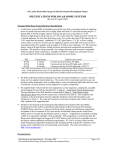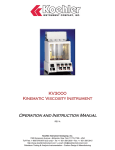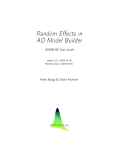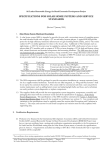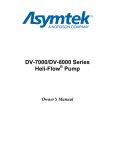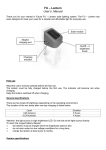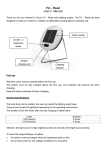Download PV GAP RECOMMENDED SPECIFICATION PVRS 11A
Transcript
PV GAP RECOMMENDED SPECIFICATION PVRS 11A 2005-03 Amendment 1, 2009-12 Portable solar photovoltaic (PV) lanterns– Design qualification and type approval Amendment 1, Extension to include lanterns with nickel-metal hydride batteries Reference number PVRS 11A : 2004 Amendment 1:2009 Page 0 of 35 PV GAP RECOMMENDED SPECIFICATION PVRS 11A 2005-03 Amendment 1, 2009-12 Portable solar photovoltaic (PV) lanterns– Design qualification and type approval (reproduced by kind permission of the World Bank/UNDP Energy Sector Management Programme (ESMAP), whose support in the preparation of this publication is acknowledged by PV GAP) Amendment 1, Extension to include lanterns with nickel-metal hydride batteries ©PV GAP 2009 Copyright - all rights reserved No part of this publication may be reproduced or utilised in any form or by any means, electronic or mechanical, including photocopying and microfilm, without permission in writing from the publisher. PV GAP Secretariat c/o IEC Central Office 3 rue de Varembé - PO Box 131 - 1211 Geneva 20 – Switzerland Fax: 41 22 919 03 00 PRICE Page 1 of 35 USD 20 PVRS 11A © PV GAP : 2005. Amendment 1, 2009 CONTENTS Foreword............................................................................................................................................... 3 1 Scope………………………………………………………………………………………………………… 4 2 Purpose ........................................................................................................................................... 4 3 Normative and informative references............................................................................................. 5 4 Abbreviations ................................................................................................................................... 5 5 Testing methods .............................................................................................................................. 6 6 Marking ............................................................................................................................................ 10 7 Pass criteria ..................................................................................................................................... 10 8 Manual ............................................................................................................................................. 13 9 Major defects .................................................................................................................................. 13 10 Load specification ............................................................................................................................ 13 11 Solar PV module test……………………………………………………………………………………….. 14 12 Switching and solar module connector durability……………………………………………………….. 14 13 Protection against open-circuit, short-circuit and reverse polarity tests………………………………. 15 14 Shipping vibration test……………………………………………………………………………………….. 16 15 Solar lantern performance tests……………………………………………………………………………. 16 16 Solar lantern testing sequence………………………………………………………………………………. 19 17 Determination of the system balance point…………………………………………………………. ….…. 22 18 Indoor testing using a PV module simulator……………………………………………………………………23 19 Modifications……………………………………………………………………………………………………. 24 20 Report………………………………………………………………………………………………………….. 24 Annex A (Normative) Classification of Irradiation and Systems………………………………………………. 25 Annex B (Normative) Instrumentation and Equipment for the System Test………………………………….. 26 Annex C (Normative) Determination of the module output for indoor testing using a PV module simulator…28 Annex D (Informative) Design Recommendations……………………………………………………………….. 33 Annex E (Normative) Declaration of compliance – PV modue……………………………………………………34 Annex F (Normative) Declaration of compliance – Battery………………………………………………………..35 Page 2 of 35 PVRS 11A © PV GAP : 2005. Amendment 1, 2009 FOREWORD 1) PV GAP (Global Approval Program for Photovoltaics) is a not-for-profit international organization, dedicated to the sustained growth of global photovoltaics (PV) markets to meet energy needs world-wide in an environmentally sound manner. Its mission is to promote and encourage the use of internationally accepted standards, quality management processes and organizational training in the design, fabrication, installation, sales and services of PV systems. To this end, it partners with PV related industries, international organizations, testing laboratories, government agencies, financing institutions, nongovernmental organizations, and private foundations, in developing and developed countries. 2) PV GAP co-operates closely with the International Electrotechnical Commission (IEC) in respect of standardization (principally with IEC Technical Committee N° 82, Solar Photovoltaic Energy Systems) and certification (with the IEC System for Conformity Testing and Certification of Electrical Equipment and Components (IECEE)). PV GAP publishes specifications that have been developed and recommended by experts from the PV industry and other organizations, to be used as interim, recommended specifications until the corresponding IEC standards can be completed. The acceptance of these PV GAP “Recommended Specifications” is voluntary. PV GAP only recommends these specifications but disclaims any liability for their utilization. It should be noted that, as soon as a corresponding IEC standard is issued, the PV GAP “Recommended Specification” is withdrawn. This is announced on the PV GAP website www.pvgap.org, together with information about the new IEC standard. 3) The present PV GAP Recommended Specification has been endorsed by the PV GAP Technical Committee, and approved by the PV GAP Executive Board. Members of the Technical Committee and the Executive Board bodies are listed on the website www.pvgap.org.) Changes to the first edition 2005 are mainly as follows: 1. In clause 1, the scope is extended to include lanterns with nickel-metal hydride (NiMH) batteries. The statement on service environment is deleted, as inappropriate to solar lanterns. 2. In clause 3, the list of Standards and Specifications is amended and updated. 3. In clause 5, the limit for small PV modules is raised from 10 W to 20 W to embrace current practice. 4. Subclause 5.3, the battery is no longer included. In subclause 7.3 the battery is exempted from testing and certification, being by now a common professional/consumer off-the-shelf item, sealed and maintenance-free. However, certification of the battery manufacturer to ISO 9001 or equivalent is required, together with a Declaration (new annex F) by the solar lantern manufacturer that only such batteries are used and that their advertised cyclic endurance is traceable to test data. 5. Subclause 5.3 and subclause 14.4, it is mentioned that the lantern is packed for shipping before the vibration testing. 6. Clauses 6 Marking, 8 Manual, and 9 Major defects, originally written for Solar Home Systems, are simplified for solar lanterns. 7. In subclause 7.2 the solar lantern manufacturer may make a Declaration (new annex E) concerning the structural similarity of the solar lantern PV module to already certified larger modules. 8. Subclause 16.2 and annex D.8 introduce elapsed charging time for NiMH batteries, which inherently have no high voltage disconnect parameter at low and medium charging rates, and a low voltage disconnect figure of 1,0 V based on IEC 619512. 4) General enquiries about PV GAP may be addressed to the publisher, which is the PV GAP Secretariat, c/o IEC Central Office, 3 rue de Varembé, Box 31, CH 1211 Geneva 20, Switzerland, E-mail [email protected], telefax +41 22 919 03 01. The publisher will be pleased to receive any comments from users of this PV GAP Recommended Specification. All comments will be acknowledged. Whilst every effort has been made to ensure the accuracy of the contents of this PV GAP Recommended Specification, the publisher can accept no responsibility for any errors that may have occurred. Page 3 of 35 PVRS 11A © PV GAP : 2005. Amendment 1, 2009 PORTABLE SOLAR PHOTOVOLTAIC (PV) LANTERNS – DESIGN QUALIFICATION AND TYPE APPROVAL. AMENDMENT 1, EXTENSION TO INCLUDE LANTERNS WITH NICKEL-METAL HYDRIDE BATTERIES 1 Scope The specifications, test methods and procedures for indoor tests included in this document cover portable solar photovoltaic (PV) lanterns, which are lighting systems consisting of a lamp, a lead-acid or nickel-metal hydride (NiMH) battery and electronics, all placed in a suitable housing made of durable material such as metal or plastic and an integrated or separate PV module. The battery is charged by electricity generated through the PV module. The lantern is basically a portable lighting device suitable for indoor lighting. For the purpose of this standard the service environment of the lantern (without the PV module) can be described as being fully covered by a building or enclosure to protect it from direct rain, sun, wind-blown dust, fungus, and radiation to the cold night sky, etc, but the building or enclosure is not conditioned in terms of temperature, humidity or air filtration. A lighting device, which provides only unidirectional lighting such as typical flashlights, will not be classified as a solar lantern in the present context. The focus of the test methods and procedures in this document is on solar lantern performance and durability evaluation and therefore includes the lantern components. The results of this test are applicable to the exact components and the entire lantern configuration that are tested, as noted in the Conformity Assessment Report referred to in the IECEE Conformity Assessment Certificate (CAC) The chosen testing condition is intended to represent the majority of climatic zones for which these solar lanterns are designed. Note 1:The test procedure is composed to ensure a lifetime expectancy under conditions of normal use and in moderate climatic conditions of five years and beyond, without major need for maintenance such as change/replacement of modules, charge controller, lamps or switches. In practice, however, warranties of only one or two years are common. Note 2: The test logic is similar to that defined in IEC 62124 for Solar Home Systems (SHS). Testing laboratories qualified to test SHS against IEC 62124 have therefore both test equipment and expertise in performing the tests. Note 3: For solar lanterns, some of the regular functions of the modern charge controller in other standalone PV systems may not be available because of the more simple nature of the solar lantern. On the other hand, electronic ballast of the lamp may already be included in the electronic circuit. Note 4: The scope of this specification is limited to solar lanterns using lead-acid or NiMH batteries and fluorescent lamps. (LED modules are under consideration for a future edition). Note 5: Annex D (Informative) contains design recommendations, which are not normative. However, experience has shown that many of these design aspects are positively correlated to the solar lantern’s performance. 2 Purpose The purpose of this specification is to verify design, performance and durability of portable solar PV lanterns. While some of the individual components must be qualified, the assembled lantern needs further qualification, to ensure that the components operate properly together as specified by the lantern manufacturer. The performance test consists of a check of the functionality, the autonomy and the ability to recover after periods of low state-of-charge of the battery, and hence gives reasonable assurance that the solar lantern will not fail prematurely. Page 4 of 35 PVRS 11A © PV GAP : 2005. Amendment 1, 2009 3 Normative and informative references The documents below that are indicated as being normative contain provisions, which, through reference in this text, constitute provisions of this International Specification. At the time of publication, the editions indicated were valid. All normative documents are subject to revision, and parties to agreements based on this International Specification are encouraged to investigate the possibility of applying the most recent editions of the normative documents indicated below. Members of IEC and ISO maintain registers of currently valid International Standards. PV GAP Recommended Specifications can be obtained from PV GAP. The other documents listed are informative for the purpose of the present Specification. IEC 60068-2-6: 1995, Environmental testing – Part 2 : Tests – Test Fc: Vibration (sinusoidal) Normative IEC 60529: 1989, Degrees of protection provided by enclosures (IP Code) Normative IEC 60904-1: 2006, Photovoltaic devices. Part 1: Measurement of photovoltaic current-voltage characteristics Normative IEC 60904-2: 2007, Photovoltaic devices. Part 2: Requirements for reference solar devices IEC 60904-5 :1993, Photovoltaic devices. Part 5: Determination of the equivalent cell temperature (ECT) of photovoltaic (PV) devices by the open-circuit voltage method Normative IEC 60904-9: 2007, Photovoltaic devices - Part 9: Solar simulator performance requirements Normative IEC 61215: 2005, Crystalline silicon terrestrial photovoltaic (PV) modules – Design qualification and type approval Normative IEC 61646: 2008, Thin-film silicon terrestrial photovoltaic (PV) modules – Design qualification and type approval Normative IEC 61853, Performance testing and energy rating of terrestrial photovoltaic (PV) modules (under consideration in IEC TC 82) IEC 61951-2: 2003, Secondary cells and batteries containing alkaline and other non-acid electrolyte – Portable sealed rechargeable single cells – Part 2: Nickel-metal hydride Normative IEC 62093: 2005, Balance-of-system components for photovoltaic systems – Design Qualification natural environments IEC 62124: 2004, Photovoltaic (PV) stand-alone systems - Design Verification Normative PVRS 7A: 2005, DC supplied lighting systems with fluorescent lamps for photovoltaic (PV) stand-alone systems Normative ISO 9001:2000, Quality management systems – General requirements Normative 4 Abbreviations AC: alternating current Ah: Ampere-hours CAC: Conformity Assessment Certificate issued under the IEC System for Conformity Testing and Certification of Electrotechnical Equipment and Components (IECEE) and referring to the associated Conformity Assessment Report and the relevant Standards and Specifications CFL: compact fluorescent lamp DC: direct current Page 5 of 35 PVRS 11A © PV GAP : 2005. Amendment 1, 2009 DRT: daily run time (of the solar lantern) FS: full screen HVD: high voltage disconnect (of the charge controller) IEC: International Electrotechnical Commission (www.iec.ch) IECEE: IEC System for Conformity Testing and Certification of Electrotechnical Equipment and Components (www.iecee.org) ISO: International Organization for Standardization (www.iso.org) LCD: liquid crystal display LED: light emitting diode LVD: low voltage disconnect (of the charge controller) NCB: National Certification Body NOCT: Nominal Operating Cell Temperature NiMH: nickel-metal hydride PV: solar photovoltaic(s) PV GAP: Global Approval Program for Photovoltaics STC: Standard Testing Conditions (reference testing value of cell temperature (25°C), in-plane irradiance (1000 W/m²), air mass solar reference spectrum (AM = 1,5) for PV module or PV cell electrical performance testing) UBC: usable battery capacity VI: visual inspection 5 Testing methods The tests in this specification are performed for conditions of irradiance and temperature that cover a large part of the world where these solar lanterns are being used. However these tests can be adapted to meet other specific climatic conditions, if those are significantly different from the testing conditions in this specification. This solar lantern qualification procedure is based on two series of tests: • to test some of the solar lantern components such as the PV module, the lamp, the manual on-off switch, the module connecting device, the charge controller, and • to test the solar lantern as the entire unit. The first series of tests are component tests, to determine whether the components mentioned above are appropriate for use in a solar lantern application. The second test procedure then is a type approval, to verify whether or not the component configuration in the solar lantern is well optimised to provide the lighting services for which the solar lantern is specified. These two tests are independent and essential steps for evaluating the quality of solar lanterns. Any of the components previously tested according to the procedure in this specification and already certified do not need retesting. The fluorescent lamps test (PVRS 7A) has been developed under the leadership of PV GAP and is available through PV GAP:. Usually, solar lanterns powered by modules having a maximum STC power output less than 20 W can be subjected to a reduced test sequence, which is based on IEC 61215 and IEC 61646 respectively, described in clause 11 of this specification. However, if these modules are from a family of modules, which has a CAC or NCB Certificate to IEC 61215 or 61646, this small module is considered to be certified for the solar lantern application without any further tests. Page 6 of 35 PVRS 11A © PV GAP : 2005. Amendment 1, 2009 5.1 Sampling Three complete solar lanterns for qualification testing (plus spares as specified by the supplier) shall be taken at random from a production batch or batches. The solar lanterns shall have been manufactured from specified materials and components in accordance with the relevant drawings and process sheets and have been subjected to the manufacturer’s normal inspection, quality control and production acceptance procedures. The solar lanterns shall be complete in every detail and shall be accompanied by the manufacturer’s handling, mounting and connecting instructions, including safety instructions. A copy of the CAC or NCB Certificate for the PV-module and relevant test certificate for the lamp(s) shall be included, if present. Otherwise these tests must be performed independently. When the solar lanterns to be tested are prototypes of a new design and not from production, this fact shall be noted in the test report (clause 20). In this case, CACs and certificates will not be eligible for type approval certification. If the lamps are sealed or components are not accessible (potted) and the configuration is based on an inverter/electronic ballast between battery and fluorescent lamps, the solar lantern has to be provided in a non-sealed/potted version, with the components accessible for measuring current/voltage characteristics to perform the tests. If DC CFL units with integrated inverter are used, this is not necessary, even when the lantern is potted. The lamp current will then be measured with an interface between lamp socket and lamp. If the solar lantern is designed for different lamps with different run times for each lamp, the configuration with the largest power consumption shall by default be tested. The manufacturer may, however, deviate from this procedure and select the configuration for which he wants to get the certification. 5.2 Testing sequence In carrying out the tests, the test operator shall strictly follow the manufacturer’s handling, mounting and connection instructions. First, two of each of the components shall be subjected to the test sequences in this specification, carried out in the order laid down. If both components fail any test, the design shall be deemed not to have met the qualification requirements. If one of the two components fails any test, the third component shall be subjected to the whole of the relevant test sequence from the beginning. If this component also fails, the design shall be deemed not to have met the qualification requirements. Once all the components have passed the component tests, the solar lanterns shall be subjected to the shipping vibration test and the lantern performance test. The procedures of the lantern performance test are subdivided into three different tests: the functional test, the autonomy test and the recovery test. The lantern shall be subjected to the test sequences in this specification, carried out in the order described. If both lantern samples fail any test, the design shall be deemed not to have met the qualification requirements. If one of the two lantern samples fails any test, the third lantern shall be subjected to the entire relevant test sequence from the beginning. If this lantern also fails, the design shall be deemed not to have met the qualification requirements. Figure 1 represents the qualification process. Page 7 of 35 PVRS 11A © PV GAP : 2005. Amendment 1, 2009 Sampling Check for completeness, certificates etc. For each component Certificate? Yes No Test of components Pass/Fail Fail Pass Test on system Performance characteristics Pass/Fail Figure 1. Flow diagram representing the qualification process 5.3 Testing levels and criteria The following table contains an overview over the tests, testing conditions and criteria. Test Conditions Criteria PV module The PV module as specified by the manufacturer and included in the set shall have a CAC or NCB Certificate (constitutes acceptability). IEC 61215, or IEC 61646. PV module The PV module does not have a CAC or NCB Certificate but the criteria to the right are met (constitutes acceptability). Module is identical regarding material used, production process and production site, to modules for which the manufacturer holds certification, except the power output is lower than 20 W PV module The PV module does not have a CAC or NCB Certificate, the module power is lower than 20 W and the manufacturer does not manufacture certified modules of otherwise identical type. A standard module test is passed, limited to Certificate required acceptability) PVRS 7A or equivalent national standards Lamp (constitutes • • • Page 8 of 35 Outdoor exposure test Damp-heat test, and Robustness of terminations test. PVRS 11A © PV GAP : 2005. Amendment 1, 2009 • Functionality and safety evaluated • Resistance of connector <20 mΩ. Switching and PV module connector durability test 1 000 cycles. Open circuit test of the ballast Input voltage 1,2 times the nominal battery voltage, repeat twice. The lantern shall function. Open circuit test of the charge controller Remove the battery. Apply 1,25 times open-circuit voltage to the PV module input terminals of the charge controller. The charge controller must withstand the condition without any damage. Reverse polarity of the PV module Apply a reverse polarity voltage equal to 1,5 times the nominal opencircuit voltage of the PV module to the PV module input terminals of the charge controller. The charge controller must withstand the condition without any damage. Reverse polarity of the battery Apply a reverse polarity voltage equal to 1,2 times the nominal battery voltage to the battery input terminals of the charge controller. The charge controller must withstand the condition without any damage. Fuses The battery shall be protected against short-circuit by (a) fuse(s), as close as possible to the battery terminal(s). Overcurrent devices shall be rated for at least 156% of the short circuit current (at STC) and shall have a voltage rating of at least 125% Voc. Shipping vibration test 10 Hz to 150 Hz Amplitude: 3,5 mm, acceleration: 2 g 1 octave/min, Duration on each axis: 2 h; overall: 6 h. Lantern packed for shipping before the vibration testing. The lantern shall function. System tests The functional test, the autonomy test and the recovery test. performance 1. The lamp must function at all stages of the test unless the charge controller has disconnected the lamp due to a low battery state of charge (LVD). 2. The battery capacity shall not decrease over the testing period more than 10%, expressed by (C0C2)/C0 < 10%; Co is the initial battery capacity and C2 is the final battery capacity. 3. Recovery: The ‘recovery test’ should exhibit an upward trend in the system voltage. During the recovery test, the total net Ah into the battery should be >=50% of C1 where C1 is the battery capacity after recovery test. 4. After capacity test C1, the load shall begin operating again on or before the third ‘recovery test’ cycle. 5. The System Balance Point (see System Characterisation Plot) shall match the defined minimum irradiation class or be below. 6. The measured days of autonomy shall match the defined minimum days of autonomy as indicated by the manufacturer or be above. 7. The lamp shall operate undamaged according to the manufacturer’s specification at the maximum battery voltage occurring during periods of high irradiance and at high state of charge. 8. No sample shall exhibit any abnormal open-circuit or short-circuit during the tests. Page 9 of 35 PVRS 11A © PV GAP : 2005. Amendment 1, 2009 6 Marking The manufacturer shall provide the solar lantern and the PV module (if not integrated) with the following clear and indelible markings: • name, monogram or symbol of the manufacturer/supplier; • type or model number; • nominal module and battery voltage; • serial or batch number; • polarity of terminals or leads; • precautionary warning concerning special requirements for storage, putting into service and handling. Labelling on equipment shall be in accordance with good ergonomic principles so that warning notices, controls, indications, testing facilities, fuses etc., are sensibly placed and logically grouped to facilitate correct and unambiguous identification. 7 Pass criteria A solar lantern design shall be judged to have passed the qualification test, if each test sample meets all the following criteria: 7.1 Solar lantern completeness The lantern shall be complete and contain the following elements: • all the necessary hardware; • specification by the manufacturer of daily run time (DRT) under testing conditions. For the purpose of this test, DRT is based on the irradiation class III, as shown in annex A; • specification by the manufacturer concerning the design load (Wh), the irradiation level for which this design load can be energized by the solar lantern, the autonomy and the classification under design conditions (see annex A). These specifications enable the testing laboratory to verify the manufacturer’s calculations; • specification by the manufacturer concerning the days of autonomy under testing conditions; • certificates; • manual, as described in clause 8. 7.2 The PV module The PV module as specified by the manufacturer and included in the set shall have a CAC or NCB Certificate to IEC 61215 in case of crystalline silicon PV modules and IEC 61646 in case of thin film PV modules. In case the module does not have a CAC or NCB Certificate, the following three requirements shall be met: (i) the module manufacturer already has a CAC or NCB Certificate for larger module(s), and (ii) the module for the solar lantern application is less than 20 W total power, and Page 10 of 35 PVRS 11A © PV GAP : 2005. Amendment 1, 2009 (iii) the module for the solar lantern applies the same materials (including but not limited to solar cells, interconnecting material, encapsulants, junction box connections) and is made in the same factory using the same manufacturing installation as for the module(s) for which the manufacturer has received the CAC or NCB Certificate. The solar lantern manufacturer shall make a formal declaration in writing to this effect (model declaration in annex E), if the CAC or NCB Certificate does not mention the solar lantern module. In case the module does not have a CAC or NCB Certificate and one or more of the above three criteria do not apply, the module shall be qualified for solar lantern application following the tests described in clause 11. Note: The reason for simplifying some of the requirements for modules of solar lantern is based on the following: Solar lanterns are designed for a minimal lifetime of five years or less (warranties of only one or two years are common), and normally their price tag reflects the lower life expectancy compared to larger systems. In view of the different lifetime expectation and the smaller sizes, it is justified to reduce some of the severe tests of IEC 61215 and IEC 61646 respectively. Therefore the retesting of the module is unnecessary if the module manufacturer already has in the same module family larger modules certified under the IECEE or under an NCB’s own certification program. 7.3 The battery The battery as specified by the solar lantern manufacturer and included in the set is exempted from testing and certification requirements, except that the battery manufacturer shall hold current certification to ISO 9001 for the site(s) at which the battery (for NiMH batteries, the single NiMH cells) are manufactured, issued by an accredited certification body or registrar. The solar lantern manufacturer shall make a formal declaration in writing (model declaration in annex F) that only such batteries are used, and provide a copy of the ISO 9001 or equivalent certificate and (for lead-acid batteries) the data sheet that includes cylclic endurance at various depths of discharge and is traceable to the battery manufacturer’s test data obtained in-house or from an independent testing laboratory. 7.4 The lamp(s) The lamp(s) as specified by the manufacturer and included in the set shall have a type approval certificate from an internationally recognised PV quality system. The lamp(s) shall be certified according to PVRS 7A or to an equivalent national standard. 7.5 Protection against open-circuit, short-circuit and reverse polarity The inverter shall be protected against damage from voltage under open-circuit conditions (for example, when the lamp is removed or has failed). The charge controller shall be protected against damage from voltage under open-circuit conditions when the battery is removed or has failed and from short-circuit conditions when the PV module terminals are short-circuited. The charge controller shall be protected against damage from reverse polarity conditions of battery and PV module. 7.6 Fuses and circuit breakers The battery shall be protected against short-circuit by (a) fuse(s), as close as possible to the battery terminal(s). Soldered fuses on the printed circuit board are also allowed. Where fuses of different capacity are installed, they shall have clear colour coding or labelling or be of different physical size. Page 11 of 35 PVRS 11A © PV GAP : 2005. Amendment 1, 2009 Fuses shall • be sized per the conductor size and per the component they are protecting as specified by the manufacturer, • be marked with rated current, voltage and use (AC or DC), • be rated for DC service in DC applications, and • have appropriate voltage ratings for the circuit they are protecting. Overcurrent devices protecting PV source and output circuits and carrying currents from the PV modules shall be rated for at least 156% of the short circuit current (at STC) and shall have a voltage rating of at least 125% Voc. 7.7 Switch and module connectors Switches suitable for DC use are to be provided on the lantern. The switch shall be able to withstand a minimum of 1 000 cycles under load. The PV module connector shall be able to withstand a minimum of 1 000 connections cycles. A test sequence is provided in clause 12. 7.8 System performance tests The solar lantern shall pass the system performance tests described in clause 15 The following pass-fail-criteria apply: 1. The lamp must function at all stages of the test unless the charge controller has disconnected the lamp due to a low battery state of charge (LVD). 2. The battery capacity shall not decrease over the testing period more than 10%, expressed by (C0-C2)/C0 < 10%; Co is the initial battery capacity and C2 is the final battery capacity. 3. Recovery: the ‘recovery test’ should exhibit an upward trend in the system voltage. During the recovery test, the total net Ah into the battery should be >=50% of C1 where, C1 is the battery capacity after recovery test. 4. After capacity test C1, the load shall begin operating again on or before the third ‘recovery test’ cycle. 5. The System Balance Point (see System Characterisation Plot) shall match or not exceed the defined minimum irradiation class. 6. The measured days of autonomy shall match or exceed the defined minimum days of autonomy as indicated by the manufacturer. 7. The lamp shall operate undamaged according to the manufacturer’s specification at the maximum battery voltage occurring during periods of high irradiance and at high state of charge. 8. No sample shall exhibit any abnormal open-circuit or short-circuit during the tests. 7.9 Visual evidence of a major defect There shall be no visual evidence of a major defect, as defined in clause 9, both before and after the components tests as well as the system performance test as described in clause 15. Page 12 of 35 PVRS 11A © PV GAP : 2005. Amendment 1, 2009 8 Manual It is recommended that the manual be written in English and the user’s language and include • a complete list of the solar lantern’s external mechanical and electrical components and spare/replaceable parts, • battery safety requirements including replacement procedures, • lamp maintenance/replacement procedures, • installation instructions that ensure proper placement of the PV module, • procedures for proper operation, including load conservation during periods of inclement weather, and/or a low voltage disconnect event. A checklist that contains what to do in case of a solar lantern failure shall be included. The procedures for checking that the PV module is not shaded and how to prevent shading must be explained, • maintenance items, and Instead of a written user’s manual, illustrations may be used where appropriate. Lantern performance should be specified in • rated average energy supply (Wh/day), • autonomy (days without sunshine the lantern can service the load), and • hours of use of lamp. The above recommendations may be revised, and in some cases made mandatory, in the light of practical experience. 9 Major defects For the purpose of design qualification, the following are considered to be major defects: • failure of any solar lantern component; • browning of any printed circuit board; • loss of mechanical integrity, to the extent that the operation of the solar lantern would be impaired; • deterioration of wiring insulation; • electrolyte leakage from the batteries; • signs of overheating or corrosion. 10 Load specification Many solar lanterns have multiple lighting modes, e.g. by incorporating two lamps or by electronic controls. For the purpose of this test the lamp shall be operated at maximum power. The manufacturer shall specify the daily number of hours the system can service the load under the test conditions described in this specification (DRT). This number shall be derived using the irradiation class III, specified in Annex A. Page 13 of 35 PVRS 11A © PV GAP : 2005. Amendment 1, 2009 For the purpose of the test and while the PV modules are connected, the load is never operated during daylight or at times when the solar irradiance is above 50 W/m². 11 Solar PV module test The purpose of this test sequence is to determine the electrical characteristics of the module and to show, as far as possible within reasonable constraints of cost and time, that the module is capable of matching the expected lifetime, which a solar lantern is expected to have. The test is a simplified version of the IEC module test according to IEC 61215 in case of crystalline silicon PV modules and according to IEC 61646 in case of thin-film PV modules. For the purpose of this standard the testing procedure under clause 10 of IEC 61215 or IEC 61646 is limited to the following three tests: • • • outdoor exposure test ; damp-heat test ; robustness of terminations test. 12 Switching and PV module connector durability test 12.1 Purpose The purpose of this test is to ensure that the used switch and PV module connector are able to withstand normal use and do not fail prematurely. 12.2 Procedure Subject the switch to an initial electrical resistance measurement test. In case the switch has a resistance of more than 20mΩ, the switch has failed the test. Make sure the lantern is fully charged and ready for use. (a) Switch on the lamp; in case there is more than one switch, use all the switches. (b) Switch off the lamp. (c) Connect the PV module to the lantern housing. (d) Flex the module cable at the connector and disconnect the module from the lantern. Repeat the procedure 1 000 times. Measure the electrical resistance over the module connection. 12.3 Requirements None of the components must show signs of wear that endanger the functionality or cause potential safety hazards. The switch must function and the module connector shall not exhibit an electrical resistance value more than 20 mΩ. Page 14 of 35 PVRS 11A © PV GAP : 2005. Amendment 1, 2009 13 Protection against open-circuit, short-circuit and reverse polarity tests 13.1 Open-circuit test of the ballast 13.1.1 Procedure A. Connect the lamp with the electronic ballast to a regulated power supply. Adjust the input voltage to 1,2 times the nominal battery voltage. Remove the lamp, switch on/off twice, leave the set-up for 1 hour and put the lamp back. Wait at least 1 minute. Repeat this test twice without waiting for 1 hour. Requirement: the lantern shall function. B. Connect the electronic ballast to the regulated power supply. Do not connect the lamp. Adjust the input voltage to 1,2 times the nominal battery voltage, wait at least 1 minute and measure the input current. Requirement: The ballast shall function properly. This is normally the case when the input current is not more than 10 mA. Note 1: Not all lanterns incorporate electronically controlled ballasts. 13.2 Open-circuit test of the charge controller 13.2.1 Procedure Apply a voltage equal to 1,25 times the open-circuit voltage of the PV module to the PV module input terminals of the charge controller using a regulated power supply. Remove the battery. Wait at least 1 minute. Requirement: the charge controller must withstand the condition without any damage..In case of removing the battery, the PV voltage must not “snap through” to the load terminals! Otherwise the load can be destroyed. This means, the charge controller must shut down the PV-voltage in case of a removed battery. 13.3 Reverse polarity test of the charge controller 13.3.1 Procedure for reverse polarity of PV module Apply a voltage equal to 1,5 times the nominal open-circuit voltage of the PV module to the PV module input terminals of the charge controller using a regulated power supply connected with reverse polarity. Wait at least 1 minute. Requirement: the charge controller must withstand the condition without any damage. 13.3.2 Procedure for reverse polarity of battery Apply a voltage equal to 1,2 times the nominal battery voltage to the battery input terminals of the charge controller using a regulated power supply connected with reverse polarity. Wait at least 1 minute. Observe any irregularities (excessive heat, smoke, fire, damaged components, etc) with the charge controller. Requirement: the charge controller must withstand the condition without any damage. Note: battery protection fuses may blow, which is a normal situation and does not lead to failure of this test. Page 15 of 35 PVRS 11A © PV GAP : 2005. Amendment 1, 2009 14 Shipping vibration test 14.1 Purpose The purpose of this test is to identify mechanical weak points and/or to ascertain any deterioration of the specified performance. According to IEC 60068-2-6, it must be conducted on structural elements or devices, which are exposed to harmonic vibrations during shipment, such as occur on ships, in aircraft and land vehicles. 14.2 Requirements Frequency range: 10 Hz to 150 Hz Constant amplitude: 3,5 mm Constant acceleration: 2g Cycling: 1 octave/min Duration on each axis: 2h Total test duration: 6h 14.3 Apparatus See IEC 60068-2-6. 14.4 Procedure See IEC 60068-2-6. The specimens are packed for shipping and not energised during the test. 15 Solar lantern performance tests 15.1 Instrumentation and Equipment Annex B contains a description of the instrumentation and equipment for the solar lantern tests. 15.2 Test documentation In addition to recording all the relevant system data, the test operator shall keep relevant test data, calculations, and appropriate comments. An electronic copy of the system data shall be kept for future reference. 15.3 Installation Operate the solar lantern according to the manufacturer’s instructions. For indoor testing, a 'class C’, or better, solar simulator, as defined in IEC 60904-9, shall be used. 15.3.1 Solar lantern preconditioning Follow the manufacturer’s instructions for preconditioning the battery for system operation. In the case of a lead-acid battery, if battery preconditioning is not called for in the solar lantern documentation, the battery shall be subjected to: • at least five cycles from HVD to LVD in an outdoor test or at least five cycles at C 10 for an indoor test. Page 16 of 35 PVRS 11A © PV GAP : 2005. Amendment 1, 2009 NOTE: Certain advanced charge controllers need a few days/cycles to find the optimum settings matching the system design. The manufacturer shall state this and the performance test shall be preceded by the prescribed number of cycles. PV modules exhibiting light-induced degradation (e.g. amorphous silicon) shall be subjected to initial light soaking according to IEC 61646. 15.3.2 Verify load operation The lamp is an integral part of the solar lantern and the size of the lamp is an important design parameter. Lanterns may contain more than one lamp or can be varied in brightness. For the purpose of this test, always the maximum light output as specified by the manufacturer shall be used. Verify that the lamp starts and operates properly. In systems with multiple lamps, verify that each individual lamp can start and run while all other lamps are operating. For this test, it is only necessary to operate the lamp(s) long enough to determine whether they function correctly. Turn off all lamps after verifying they operate properly. 15.3.3 Data acquisition system installation Install the plane of module irradiance sensor (reference device). The irradiance sensor shall be as close as possible to the PV module without shading the module and shall be mounted in the same plane and within +/- 5° of the module tilt angle. Program the data acquisition system to monitor the measurement parameters and store as 5-minute averages. Install the temperature sensors: • The ambient temperature sensor must be mounted in an aspirated or double shaded shield. • The temperature sensor on the back of the module must be mounted in the middle of a solar cell within the centre of a module, utilising thermal paste and covering the sensor with insulation material and foil. The battery temperature sensor must be mounted as close as possible to the temperature compensation sensor. If temperature compensation is internal to the charge controller, a temperature sensor in addition to the battery temperature sensor shall be mounted to sense the controller temperature. Install voltage sensors for the PV module and loads. Install the voltage sensor for the battery at the battery terminals. Maximum and minimum values of the signals specified in Table shall also be collected and stored. Install current sensors for the PV module, battery and lamp. Calculate module and load DC Power. DC power may be computed by multiplying average DC voltage and average DC current. Install a sensor to detect proper load operation, for example a light sensor in front of a lamp. NOTE: In case of a fluorescent lamp, it would not be adequate to only look at the current load as an indicator of load operation as the lamp could malfunction yet the ballast may continue to draw current. Note the load operation method. Modify a copy of the schematic to show the data acquisition system sensor locations. This modified schematic shall be included in the report of clause 20. 15.3.4 Lantern photographs Photograph the lantern after the lantern has been instrumented. Include the photos with the documentation. Page 17 of 35 PVRS 11A © PV GAP : 2005. Amendment 1, 2009 15.4 Visual inspection The lantern and its components must be checked for damage and workmanship (for example, suitability of structural elements) After each test, flex all conductors along their entire length, noting any discoloration or brittleness of the insulation. Undersized conductors and poor connections will tend to overheat, leading to brittle and discoloured insulation. Any peculiarities observed must be carefully documented in the report (clause 20) and if necessary by means of photography. Verify that all parts listed on the parts list are present. Note any missing system parts that should have been included. If essential parts, i.e. parts without which the system cannot go through the testing procedure, are missing, the system fails the test and shall be sent back to the manufacturer. 15.5 Test sequences The following graph indicates the different steps of the system performance test, as described in more detail in clause 16: B attery V o ltage U BC 0 P V on L oad O ff V reg BC FT P V on P V off L oad O ff L oad O n contin uou sly T =12 h rs U BC 1 P V on L oad O n PV on Lo ad O ff T<0.5 hr RT PV off Load O n continuou sly UBC2 PV on Lo ad O n (see text) P V o ff Lo ad O n co ntinu ously T<0.5 hr LV D H old at LV D fo r at least 0.5 hrs H old at LV D fo r at least 0.5 hrs TIM E V I = V isua l Inspe ction VI VI VI VI S am p le Test P ro file for the solar lantern p erform an ce test Various test sequences are applied during the test to verify performance for low discharge, battery recovery, functionality operation and ability to reach HVD/full charge under normal operation in sunny weather, even after having been completely discharged. UBC 0 = Initial Usable Battery Capacity Test: Initial capacity test – After installing the system, charge and discharge the battery, measure the usable battery capacity (UBC). Vreg = voltage level (or other parameter, e.g. elapsed time in the case of NiMH batteries) at which the controller determines a ‘full battery level’ BC = Battery Charging: Recharge the battery before running the Functional Test. FT = Functional Test: Run the Functional Test to verify that the system and load operate properly. Page 18 of 35 PVRS 11A © PV GAP : 2005. Amendment 1, 2009 UBC 1 = First Usable Battery Capacity Test: capacity test and autonomy test – Charge and discharge the battery. Measure the usable battery capacity. Determine the system autonomy. RT = Recovery Test: Determine the ability of the PV System to recharge the discharged battery. UBC 2 = Second Usable Battery Capacity: Final capacity test –Discharge the battery. Measure the usable battery capacity. 15.6 System characterisation graph Plot the values found in the tests and construct the system characterisation graph as described in clause 17. Determine the System Balance Point. 16 Solar lantern testing sequence 16.1 Solar lantern testing conditions The temperature of the batteries shall be kept at 27 °C ± 3 °C. The general ambient temperature during testing shall be within 27 °C ± 3 °C The test is valid both for using a solar simulator or a solar module simulator. Both shall have the ability to simulate the Reference Solar Day using the Daily Irradiance Profiles as described in this specification. The solar simulator shall be Class C or better. However, for days with a high solar irradiation a three-step profile is allowed. For days with a low solar irradiation, a constant value of the irradiance is allowed. This specification may be amended to allow the use of non-solar simulators upon the publication of IEC 61853: Performance testing and energy rating of terrestrial photovoltaic (PV) modules (under consideration in IEC TC 82). The requirements for the solar module simulator are described in annex C. 16.2 Initial capacity test Make sure the system has been properly preconditioned in accordance with 15.3.1. With PV on and load off allow the lantern to charge the battery by imposing at least 700 W/m². Once the lantern reaches a state of regulation (for NiMH batteries, after the elapsed time stated by the lantern manufacturer, see annex D.8), keep the lantern at this state for 12 hours. The battery will then be regarded as charged. With PV off and load on continuously, allow the lantern to fully discharge the battery. The battery is fully discharged when it reaches LVD, see annex D.8 . Allow the battery to remain at LVD for 5 hours. Record the number of Ah discharged from the battery. This is the Initial Usable Battery Capacity (UBC 0 ). Perform a visual inspection as described in the section in accordance with 15.4. 16.3 Battery charge cycle Switch off the light. Set the simulator at 700 W/m² ± 50 W/m². With PV on and load off let the lantern recharge the battery till it has reached regulation (HVD) (for NiMH batteries, after the elapsed time Page 19 of 35 PVRS 11A © PV GAP : 2005. Amendment 1, 2009 stated by the lantern manufacturer). Allow the lantern to stay there for a maximum of 0,5 hours. Record the number of Ah recharged into the battery. 16.4 Lantern functional test This test verifies the lantern can service the load as intended. With PV on and light on as specified by the manufacturer in accordance with clause 10, allow the lantern to operate 'normally' for 10 days. The following figure gives an overview of the recommended irradiance profiles to be used in the test: Page 20 of 35 PVRS 11A © PV GAP : 2005. Amendment 1, 2009 Daily Irradiance Profiles for Functional Test, 10 days Irradiance 1 kWh/m² 1 6 kWh/m² 2 5 kWh/m² 1 kWh/m² 1 kWh/m² 3 4 5 Cycles Irradiance Irradiance (W/m²) 800 5 kWh/m² 5 kWh/m² 5 kWh/m² 6 kWh/m² 6 kWh/m² 6 7 8 9 10 Day with high solar irradiation (6 kWh/m² Total) Day with high solar irradiation (5 kWh/m² Total) Cycles Day with low solar irradiation (1 kWh/m² Total) 700 600 500 400 300 200 100 6 7 8 9 10 11 12 13 14 15 16 17 18 7 8 9 10 11 12 13 14 15 16 17 Time (h) Page 21 of 35 0 5 PVRS 11A © PV GAP : 2005. Amendment 1, 2009 Table 1: Cycles of the performance test Cycle # Cycle 1: Cycle 2: Cycle 3: Cycle 4: Cycle 5: Cycle 6: Cycle 7: Cycle 8: Cycle 9: Cycle 10: Irradiance profile Day with low irradiation (1 kWh/m²), operate load Day with high irradiation (6 kWh/m²), operate load Day with low irradiation (1 kWh/m²), operate load Day with low irradiation (1 kWh/m²), operate load Day with high irradiation (5 kWh/m²), operate load Day with high irradiation (5 kWh/m²), operate load Day with high irradiation (5 kWh/m²), operate load Day with high irradiation (5 kWh/m²), operate load Day with high irradiation (6 kWh/m²), operate load Day with high irradiation (6 kWh/m²), operate load The cycles do not necessarily have to cover 24 hours, since no rest time between operation of the load and the PV charging is required. The following irradiation profiles are minimum requirements that must be applied, better (smoother) profiles leading to a similar daily sum are also allowed: Day with high solar irradiation (6 kWh/m²day +/- 0.3 kWh/m²) 1 hour at 100 W/m² 3 hours at 500 W/m² 4 hours at 700 W/m² 3 hours at 500 W/m² 1 hour at 100 W/m² Day with high solar irradiation (5 kWh/m²day +/- 0.3 kWh/m²) 1 hour at 100 W/m² 2 hours at 500 W/m² 4 hours at 700 W/m² 2 hours at 500 W/m² 1 hour at 100 W/m² Day with low solar irradiation (1 kWh/m²day +/- 0.3 kWh/m²) 5 hours at 200 W/m² Perform a visual inspection in accordance with 15.4. 16.5 Second capacity test plus autonomy test Disconnect the load after the functional test. Set the simulator at 700 W/m² ± 50 W/m². With PV on and light off recharge the battery till it has reached regulation (HVD) (for NiMH batteries, after the elapsed time stated stated by the lantern manufacturer) and stays there for a maximum of 0,5 hours. Disconnect the PV module and switch on the lamp. Allow the lantern to discharge the battery until it reaches LVD. Determine the lantern autonomy. Determine the number of Ah discharged from the battery and the total time to discharge. This is the Second Usable Battery Capacity (UBC 2 ). Allow the battery to remain at LVD for at least 5 hours but not more than 72 hours. Page 22 of 35 PVRS 11A © PV GAP : 2005. Amendment 1, 2009 Perform a visual inspection in accordance with 15.4. 16.6 Recovery test Connect the PV module and switch off the lamp. Operate the solar simulator with an irradiance profile of a day with high solar irradiation (5 kWh/m²) in accordance with 16.4. Then connect the load as specified by the manufacturer in accordance with clause 10. NOTE - The lantern may still have low-voltage protection at this time. If that is the case, disconnect the load again and operate the solar simulator with an irradiance profile of a day with high solar irradiation (5 kWh/m²) in accordance with 16.4. Then connect the load as specified by the manufacturer in accordance with clause 10. Once the load comes on, wait until the lantern reaches LVD or the Daily Run Time has passed. Repeat this test until the lantern has gone through seven recovery test cycles. The lantern has then been exposed to an overall irradiation of 35 kWh/m². If the lantern reaches HVD (in the case of NiMH batteries, full charge calculated on the basis of elapsed time, record after how many recovery test cycles HVD/full charge was reached. Record at which ‘recovery test cycle’ the load started to operate. Measure the net Ah into the battery and to the load during seven Recovery Test Cycles. After these recovery test cycles switch off the lamp (for NiMH batteries allow the voltage to fall to LVD), set the simulator at 700W/m² ± 50W/m² and wait until the lantern reaches a state of regulation (for NiMH batteries, completion of the elapsed time stated by the manufacturer for full re-charging). Once the lantern reaches a state of regulation, keep it at this state for 12 hours. The battery can then be regarded as fully charged. Perform a visual inspection in accordance with 15.4. 16.7 Final capacity test With PV off and light on continuously, allow the lantern to fully discharge the battery. The battery is fully discharged when it reaches LVD. Allow the battery to remain at LVD for 5 hours. Record the number of Ah discharged from the battery. This is the Final Usable Battery Capacity (UBC2 ). 16.8 Operation at maximum voltage Verify the suitability of the light operated at the maximum battery voltage occurring during periods of high irradiance (between 800 and 1000 W/m²) and at high state of charge. The light shall be operated for a period of 1 hour under these conditions. The light shall operate undamaged. Note: there are lanterns on the markets that have a built-in automatic protection mechanism, preventing simultaneous charging of the battery and use of the lamp. For such lanterns this test cannot be carried out. 16.9 Visual inspection Perform a visual inspection in accordance with 15.4. 16.10 Unusual occurrences Note any unusual occurrences during the test period. circuits, data acquisition system malfunctions, etc. These may include unplanned short or open Page 23 of 35 PVRS 11A © PV GAP : 2005. Amendment 1, 2009 17 Determination of the System Balance Point The lantern characterisation plot gives a graphical representation of the minimum average irradiation that the intended location must have for the lantern to function properly. Sum the Ah into the battery and the irradiation for each day during the functional and recovery tests. Plot the battery Ah along the Y-axis vs. irradiation along the X-axis. The data should tend to fall along and in between two lines similar to those shown in example in Figure 2. A horizontal line is drawn through the point with the minimum value of Ah for days when the charge controller limits the module current flowing into the battery. A sloped line is drawn through origin and the point with the highest value on days the controller does not limit the current flowing into the battery at any time. The System Balance Point is defined by the intersection of these lines. The System Balance Point can be determined by calculation or by using graphical means. The system as shown in Figure 2 will, for example, be suitable for locations that have at least 2,5 kWh/m²⋅day as a yearly average. Therefore the lantern would be qualified for irradiation class I (Annex A) and the specified daily load profile (Daily Run Time) which must be stated in the final test report and should correspond with the manufacturer’s lantern performance declaration. Note: a different load profile results in different characterisation chart. Daily Charged Ah into The Battery [Ah] 16 14 12 2 10 5 8 6 System Balance Point 6 4 Test Cycle 2 7 9 8 10 1 3 4 0 0 1 2 3 4 5 6 Irradiation [kWh/m² day] Figure 2. Lantern characterisation chart, charge sequence example with three irradiation profiles and 10 cycles. Discharge: constant load profile. Page 24 of 35 PVRS 11A © PV GAP : 2005. Amendment 1, 2009 18 Indoor testing using a PV module simulator 18.1 Testing conditions An electronic power supply simulating the module characteristics shall be used, which has the ability to simulate the Reference Solar Day in accordance with 16.4. Annex C describes the calculations leading to current and voltage characteristics simulating the PV module under conditions prescribed in this specification. The temperature of the batteries shall be kept at 27°C ± 3°C. The general ambient temperature during testing shall be within 27°C ± 3°C. 18.2 Initial capacity test Perform this test in accordance with 16.2. 18.3 Battery charge cycle Perform this test in accordance with 16.3. 18.4 Lantern functional test Perform the functional test in accordance with 16.4. 18.5 Second capacity test Perform this test in accordance with 16.5. 18.6 Recovery test Perform this test in accordance with 16.6. 18.7 Final capacity test Perform this test in accordance with 16.7. 18.8 Operation at maximum voltage Perform this test in accordance with 16.8 18.9 Visual inspection Perform a visual inspection in accordance with 15.4. 18.10 Unusual occurrences Note any unusual occurrences during the test period. These may include unplanned short or open circuits, data acquisition system malfunctions, etc. 19 Modifications Any change in the design, materials, components or processing of the lantern may require a repetition of some or all of the qualification tests to maintain design qualification. Page 25 of 35 PVRS 11A © PV GAP : 2005. Amendment 1, 2009 20 Report A report of the qualification tests, with measured performance characteristics and details of any failures and retests, shall be prepared by the testing laboratory. The manufacturer shall keep a copy of this report for reference purposes. Page 26 of 35 PVRS 11A © PV GAP : 2005. Amendment 1, 2009 Annex A (Normative) Classification of Irradiation and Systems A.1 Determination of the irradiation class and design irradiation Derive the Yearly Average Daily Horizontal Irradiation and the Irradiation Range from a meteorological station near the location of intended use. The Irradiation Range (H range ) is the difference between the Monthly Average Daily Horizontal Irradiation in the month with the highest irradiation and the Monthly Average Daily Horizontal Irradiation in the month with the lowest irradiation (in kWh/m²·day) Table A-1 contains a classification system for locations with different irradiation patterns. Every location can thus be allocated to an Irradiation Class. Table A-1: Irradiation Classes Irradiation Class Yearly average daily horizontal irradiation [kWh/m²·day] Range [kWh/m²·day] I II III IV V VI <4,5 <4,5 4,5-5,5 4,5-5,5 >5,5 >5,5 >1,5 <1,5 >1,5 <1,5 >1,5 <1,5 NOTE - The calculation of the DRT is based on Irradiation class III. A.2 Rating systems For a given system at a specific location, the Effective Daily Energy Available to the Load can be calculated. This will then be expressed as the Effective Daily Energy Available to the Load for a system of make X at location Y and shall be expressed in Wh. The same system may classify differently in another country, or even at another location in the same country. Page 27 of 35 PVRS 11A © PV GAP : 2005. Amendment 1, 2009 Annex B (Normative) Instrumentation and equipment for the system test. The following instrumentation and equipment is necessary for conducting the system tests: • DC voltage and DC current measuring instruments. • DC amp-hour meter or some other means of monitoring. • Elapsed time meter or some other means of monitoring. • A PV reference device that has been selected and calibrated in accordance with IEC 60904-2 to match the test modules regarding the spectral response. • Suitable instrumentation to check that the reference device and the module are co-planar to within ± 5° • Temperature sensors. • A means to identify orientation. • Automated data acquisition system to facilitate system monitoring during the test. Data acquisition system specifications The datalogger shall use at least a 12 bit analog-to-digital converter and have an input range that exceeds the expected positive and negative maximum voltages. The data acquisition system must be reliable: if more than 4 hours of data is lost, or if any critical data is lost due to power failure during any test, then that test shall be restarted. The sample rate of the datalogger is dependent on the type of charge controller. For ON-OFF controllers, the datalogger sample rate shall be at least two times faster than the switching period of the controller. As an example, if the operation of the regulation voltage circuitry is every 10 seconds, then the sample rate shall be once every 5 seconds, or faster. For charge controllers using constant-voltage or pulse-width-modulation circuitry, the switching period may be milliseconds, not seconds. The sampling rate of the datalogger should be at least twice the switching frequency of the charge controller. If the sample rate of the used datalogger is not fast enough, then one method is to sample once per second with an integrator/filter circuit added to the data acquisition system input. The time constant of the integrator/filter will need to be at least two times the sample period. An oscilloscope may be required to determine the controller type and its switching frequency. Data shall be stored as 5 minute averages as appropriate for each test. The following parameters shall be measured/determined: Page 28 of 35 PVRS 11A © PV GAP : 2005. Amendment 1, 2009 Table B-1. Parameters to be Measured/Determined Measured parameter Recorded Values Comments Module voltage Minimum, average and maximum Voltage at the module, before blocking diodes Load voltage Minimum, average and maximum Battery voltage Minimum, average and maximum Module current Minimum, average and maximum Load current Minimum, average and maximum Battery current Battery amp-hours in and out Air temperature Average Module temperature Average Use IEC 60904-5 Battery temperature average At temperature compensation sensor or negative battery terminal Solar irradiance Average Reference device, short circuit current and temperature of device Load operation Load Run Time Measured at the load Measured at the battery Sensor specifications The voltage sensors shall have a range exceeding the maximum expected voltage and the measurement shall have a resolution of 0.01 V or better. The current sensors shall have a range exceeding the expected maximum positive and negative current and the measurements shall have a resolution of 0.01 A or better. DC voltage and DC current measuring instruments shall comply with IEC Publication 60904-1, except that the accuracy shall be within ± 1% FS. The temperature sensors shall have a range exceeding the expected maximum positive and negative system and ambient temperatures and measurement resolution of 1 C or better. The temperature measurement accuracy shall be ±2 C or better. The irradiance sensor shall have a suitable range and an accuracy of at least ±5% of the reading. Page 29 of 35 PVRS 11A © PV GAP : 2005. Amendment 1, 2009 Annex C (Normative) Determination of the module output for the indoor testing using a PV module simulator. NOTE: Please be aware that certain PV module simulators may not be compatible with all types of charge controllers due to the internal switching frequencies. C.1 Constant current source simulation The following flow diagram explains the steps to be taken to arrive at appropriate settings for a constant current source simulating the PV module: Module Data (STC, NOCT) Irradiation Profile Ambient Temperature Procedure for temperature and Irradiation Correction Range of Battery Voltage Set of Array IV-Curves Performance Test Assuming the NOCT of the module is determined, only the performance of the module under STC shall be measured (refer to module performance data). The output corresponding to the conditions at the defined reference solar day has to be calculated according to following formula: Page 30 of 35 PVRS 11A © PV GAP : 2005. Amendment 1, 2009 T r an s la tio n fac to rs ⎡ ⎤ G2 I SC ,2 = I SC ,1 ⋅ ⎢1 + α ⋅ (T 2 − T1 )⎥ ⋅ ⎦ G1 ⎣ G2 ⎡ ⎤ V O C , 2 = V O C ,1 ⋅ ⎢ 1 + a ⋅ ln + b ⋅ (T 2 − T1 )⎥ 1 G ⎣ ⎦ T r an s la tio n e q u a tio n s fo r th e IV d a ta p o in ts ⎛ IS C,2 ⎞ I 2 = I1 ⋅ ⎜ ⎟ ⎝ ISC,1 ⎠ C urre n t: V o lta g e: V 2 = V1 + (V OC ,2 ) − V O C ,1 + R S ⋅ ( I 1 − I 2 ) M o d u le p ara m e te rs : dim e n sio n les s te m p era tu re c oe ffic ie nt o f I S C : dim e n sio n les s te m p era tu re c oe ffic ie nt o f V O C α b a RS : dim e n sio n les s ra dia tion co rre ctio n fac to r o f V : se ria l re s ista nc e of th e m od u le, P V arra y (d e fa u lt = 0 .0 0 05 /°C ) (d e fa u lt= -0.0 04 /°C ) (d e fa u lt= 0 .0 6 ) (d e fa u lt= 0 ) OC Temperature and irradiance correction of current-voltage characteristics As a result of the procedure for temperature and irradiance correction a set of IV-curves is defined according to the specified reference solar day. One curve for each step of the day profile is estimated. This procedure must be repeated for every profile which is used in the test sequence of the performance test. 7 6 Module current in A 5 4 3 2 1 0 0 2 4 6 8 10 12 14 16 18 20 22 M o d u l e v o lt a g e i n V T M D p e r fo r m a n c e S T C p e r fo rm a n c e L in e o f M P P Figure C-1: Set of IV characteristics for a daily irradiance profile (example) The solar lantern voltage is dominated by the battery voltage. Hence the module operates in the range of the battery voltage. The window is limited by two significant thresholds. The upper limit is the High Voltage Disconnect (HVD) set-point for lead-acid batteries (fully charged state for NiMH batteries, see annex D.8) which disconnects the module at a certain voltage (or at full charge for NiMH batteries). The lower limit is the deep discharge point which protects the battery and cannot be exceeded by normal system operation. Page 31 of 35 PVRS 11A © PV GAP : 2005. Amendment 1, 2009 The IV-curves within the window can be estimated linearly. These estimated linear lines are called operation lines. Each IV curve within the battery voltage range is defined by means of two operation lines to achieve a good estimation. The operation lines are defined by three points on the IV-curve. The point of intersection between module IV-curve and the lower voltage limit is the first point (Lx). The second point (Mx) is at the middle of the defined voltage range. The point of intersection between module IV-curve and the higher voltage limit is the third point (Hx). 11.1 V 14.6 V Line of voltage drop due to ohmic losses L6 L5 example: 5 m cable 2.5² resistance = 0.034 Ohms Voltage drop at 3 A = 0.1 V L4 L3 M3 L2 Voltage drop caused by blocking diode (approx. 0.7 V) H3 M2 H2 L1 M1 H1 10 11 12 13 14 15 16 Module voltage Figure C-2: Approximation of module characteristics by a set of module operation lines NOTE - The vertical line at 11.1 V is the Low Voltage Disconnect (LVD) and the vertical line at 14.6 V is the High Voltage Disconnect (HVD) set-point for lead-acid batteries of the charge controller. Different charge controllers, including those for NiMH batteries, have different set-points. Page 32 of 35 PVRS 11A © PV GAP : 2005. Amendment 1, 2009 C.2 Module simulation procedure The electrical behaviour of the module can be simulated by means of a programmable constant current source. Charging of the battery is controlled by the processing unit. Inputs: - current-voltage co-ordinates for the linear approximation of the module characteristics - battery voltage Output: - module current Depending on the measured battery voltage, the current is changed continuously by successive approximation steps until the current-voltage operation point fits with the module operation line. O p e r a t io n p o in t C u rr e n t fr o m c o n s ta n t c u rre n t s o u rc e I1 A rr a y o p e r a t io n li n e s p e c if ie d f o r a P T O C t im e s te p I2 I3 B a tt e r y v o l t a g e V3 V2 V1 P T O C - P e r f o rm a n c e T e s t u n d e r O p e r a t io n C o n d it io n s Figure C-3: Iteration process for current adjustment C.3 Set-up for testing The lantern without module(s) shall be installed in a climatic chamber (in case the charge controller uses a separate temperature sensor, it is possible to place only the battery in a climatic chamber or a bath). Page 33 of 35 PVRS 11A © PV GAP : 2005. Amendment 1, 2009 Figure C-4: Experimental set-up for PV system performance testing C.4 Algorithm for simulation of the module performance Initialise source Isource = IL1 Measurement of battery voltage VBat VBat fits with operation line? yes no no Ii+1 = Ii + I yes VBat > VOL? Ii+1 = Ii - I Adjustment of source current ISource = Ii+1 Flow chart for simulation of the module performance presented for one time step of the PTOC profile Page 34 of 35 PVRS 11A © PV GAP : 2005. Amendment 1, 2009 Annex D (Informative) Design Recommendations The following recommendations represent current best-practice design recommendations for portable solar PV lanterns. D.1 Reverse current Reverse current, that is to say battery discharge into the module(s), should be minimised. The means by which this is achieved should be documented. If blocking diodes are used, the current capacity should be 50% higher than the short circuit current (at STC). The peak inverse voltage of the diode should be at least double the open circuit battery voltage. D.2 Quiescent current The quiescent current i.e. the self-consumption when no lamp is lit, should not exceed 2,0 mA. D.3 Protection against dust, water and foreign bodies (IP-code) Since the solar lanterns are predominantly used indoors, but may be taken outdoors occasionally and hence may be subjected to occasional rainfall, a minimum IP class of IP23 (see IEC 60529) is recommended. This also ensures a desired level of safety with regard to accidental accessibility of live parts. D.4 Cable A water resistant, mechanically robust and UV resistant cable should be used between the solar PV module and the charge controller. A cable at least 5 m long should be provided for inter-connection between the module and the lantern The continuous maximum current rating of the conductors (after any deratings for temperature or installation conditions) in PV source and output circuits should be at least 156% of the short circuit current (at STC) and should not be less than the rating of any overcurrent device protecting those conductors. All wiring should be colour coded and/or labelled. D.5 Connectors All connectors should be polarised and be able to withstand 156% of the short circuit current at STC. The rated current carrying capacity of the connectors should not be less than the circuit current rating. D.6 Indicators The lantern should provide • an indication of charging state, and • an indication of load-disconnect state. The indicator may consist of LEDs or an LCD. Page 35 of 35 PVRS 11A © PV GAP : 2005. Amendment 1, 2009 D.7 Switching thresholds for charge controllers for lead-acid batteries The following thresholds are recommended for using the battery voltage as the main parameter for the switching algorithm, at a surrounding temperature of 20 °C and an acid concentration of 1,24 kg/l: • High Voltage Disconnect (HVD): • High Voltage Reconnect by two-point regulation (HVR): • Low Voltage Disconnect (LVD): ≥ 1,90 V/cell • Low Voltage Reconnect (LVR): ≥ 2,15 V/cell > 2,35 V/cell 2,15-2,35 V/cell At other acid concentrations, the required thresholds must be adjusted according to the manufacturer's specifications. NOTE 1: The lower limit of the Low Voltage Disconnect is an absolute minimum. NOTE 2: These values are primarily intended for charge controllers that use the battery voltage as the main parameter for the switching algorithm. Some manufacturers use other parameters, e.g. state of charge. D.8 Switching thresholds for charge controllers for NiMH batteries Due to the flat charging characteristic of NiMH batteries used in solar lanterns (typically, low to medium charging rate), there is no High Voltage Disconnect (HVD) point. Full charge is achieved when at least 150% (or as otherwise stated by the battery manufacturer) of the battery capacity has been charged into the discharged (LVD 1,0 V) battery. The simplest solar lanterns may (the word “may” is not intended to be permissive but only to introduce the following observation) not incorporate discharging to LVD and timed charge termination, relying on the daily daylight “self regulated” system instead. This may result in some overcharging, which is generally tolerated by the battery but shortens its life. The Low Voltage Disconnect (LVD) point is 1.0 V/cell (based on IEC 61951-2) unless otherwise specified by the solar lantern manufacturer. Lanterns that do not posses an LVD feature run the risk of cell destruction in series strings of cells (e.g. five cells, to provide 6,0 V at full charge) that can arise from forced reverse charging of weak cells as the battery discharges Annex E (Normative) Declaration of Compliance – PV module The Company XY hereby declares that the PV module that is used for all Company’s Solar Lanterns (hereinafter referred to as “Solar Lantern Module”) under the product name (name of the Solar Lantern) ZZ is structurally similar to modules which are currently certified to IEC 61215 or IEC 61646 or to a nationally equivalent standard (hereinafter referred to as “Certified Module”) by an accredited certification body (see Note below). “Structurally similar” means that the Solar Lantern Module is produced at the same plant, by the same processes and from the same materials as the Certified Module. (The certificate for the Certified Module must be attached to the present Declaration). CEO name, signature and date Note: to facilitate the start-up of testing and certification of Solar Lanterns to PVRS 11A Amendment 1, the above requirement for certification of the “Certified Module” is replaced until December 31 2008 by testing by an accredited testing laboratory. Test reports to IEC 61215 or IEC 61646 (or only to the three tests, outdoor exposure, damp heat and robustness of terminations of IEC 61215 and IEC 61646) must be dated 2006 or later and attached to the present Declaration. Page 36 of 35 PVRS 11A © PV GAP : 2005. Amendment 1, 2009 Annex F (Normative) Declaration of Compliance - Battery The Company XY (hereinafter refered to as “Company xy”) hereby declares that the battery that is used for all Solar Lanterns (hereinafter referred to as “Solar Lantern Battery”) under the product name (name of the Solar Lantern) ZZ is produced by a company, be it by Company xy itself or by a third party producer, (hereinafter referred to as “Production Company”) which currently holds quality management system certification issued by an accredited certification body or registrar to ISO 9001 or an equivalent standard or specification. The scope of the above certification must include the site(s)of the Producing Company, at which the Solar Lantern Batteries are manufactured(for NiMH batteries, where the single cells are manufactured). (The certificate for the quality management system must be attached to the present Declaration, together (for lead-acid batteries) with the Production Company’s data sheet that includes cyclic endurance of the lead-acid battery at various depths of discharge and which is traceable to the battery manufacturer’s test data obtained inhouse or from an independent testing laboratory). CEO name, signature and date 080212/080305/091231 Page 37 of 35






































